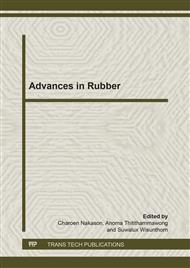p.429
p.433
p.437
p.441
p.445
p.450
p.454
p.458
p.462
Heat Built-Up of Industrial Solid Tires in Thailand
Abstract:
Solid tires made of natural rubber, manufactured and used for forklift trucks in Thailand, have quality problems involving blow out [. Failure of solid tires may occur from excessive loads and or heat generation inducing loss of mechanical properties. The failure of solid tires relating to heat generation is considered. Solid tires under severe conditions, such as overloading, high speed, or high temperature work places often leading to fail and blowout. When these are continuously rolled and loaded, the rubber is stressed and deformed leading to heat generation [. The hysteresis loss storage in form of strain energy due to internal friction in the rubber converts to the heat source transfer to the section of tire. During carrying heavy load, solid tire is subjected to the repeat compressed cyclic loading. Since rubber has the visco-hyperelastic property, cyclic load deformation causes hysteresis loop when tire is performed under cyclic load. Hysteresis loops area indicates the amount of energy turn into heat and it is difficult transferring to the surface of the tire due to insulation itself. As the results, there is heat build-up as shown in term of temperature rising differs in each tire and finally causes blowout or explosion.
Info:
Periodical:
Pages:
445-449
Citation:
Online since:
November 2013
Keywords:
Price:
Сopyright:
© 2014 Trans Tech Publications Ltd. All Rights Reserved
Share:
Citation:


